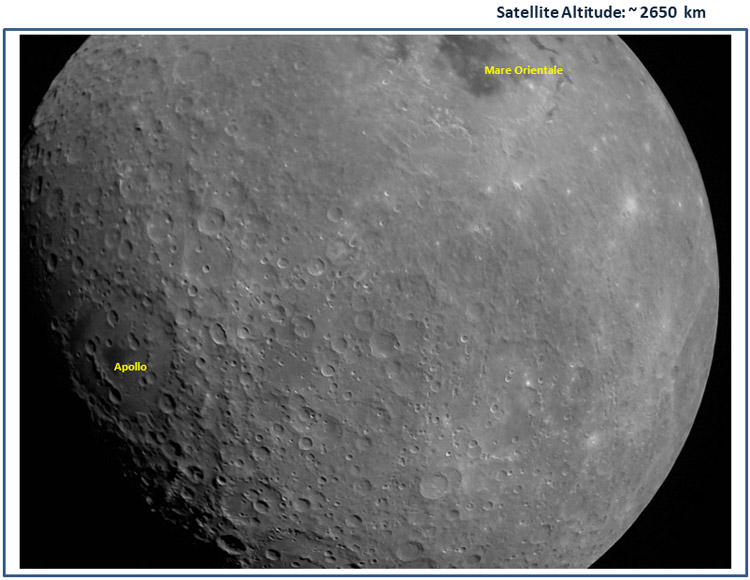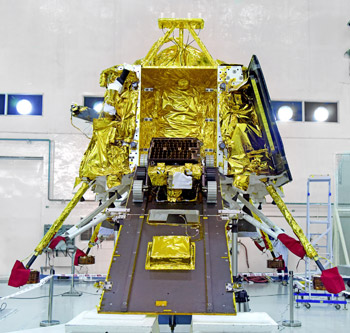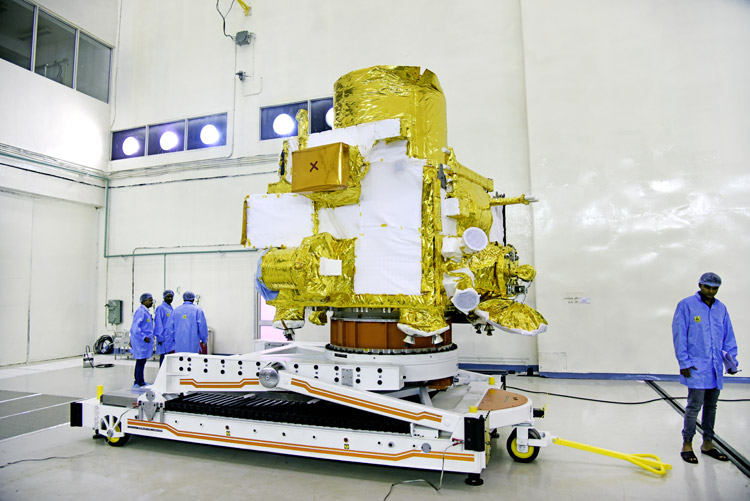- Prime Minister Narendra Modi inaugurates Aero India 2023 in Bengaluru; Releases Commemorative Stamp
- Defence Secretary meets delegations from Saudi Arabia, USA and Oman on the sidelines of Aero India 2023
- Foreign Ministers of 32 countries to attend Aero India 2023
- Embraer showcases the C-390 Millennium at Aero India 2023
All is not lost even as Vikram loses communication
Minutes before Chandrayaan-2 was about to get completed and accomplish its final phase of soft landing on the moon, all communications were lost with the lander, Vikram of Chandrayaan-2 spacecraft.

In the wee hours of September 7, India's most ambitious space program started its final descent phase to soft land on the surface of the moon. The distance of the moon from the earth is about 384,400 km and the lander of the Chandrayaan-2 spacecraft was at a mere 2.1km distance from the lunar surface when all signals were lost with the lander. Around 1:40 am, the lander, Vikram, began its power descent towards the lunar surface. Having completed complex maneuvers and extensive velocity variations, the entire power descent operation was expected to take about 15 minutes before the Vikram soft lands on the surface of the moon.
The powered descent, which India was attempting for the first time, was described as "fifteen minutes of terror" by the ISRO (Indian Space Research Organization) chairperson K Sivan earlier. "It will be a terrifying moment for us. Everybody's eyes would be glued to their consoles. The telemetry parameters will keep telling us that we are going in the right direction, but at the same time, there will be a lot of anxiety about what will happen in the next moment," Sivan had said, describing the descent as the most challenging phase of the mission.
When the 1471 kg lander was at an altitude of about 30km from the lunar surface, the power descent phase consisting of multiple phases including the rough breaking and the fine breaking phase began. While the rough breaking phase was successfully completed, the fine breaking phase began and somewhere about 2km from the surface of the moon, something did not go right.
And just when these minutes were about to get over, and success was set to embrace, terror did show up and washed all anxiousness with despair from the faces of everybody present in the ISRO mission control complex in Bengaluru.

When the 1471 kg lander was at an altitude of about 30km from the lunar surface, the power descent phase consisting of multiple phases including the rough breaking and the fine breaking phase began. While the rough breaking phase was successfully completed, the fine breaking phase began and somewhere about 2km from the surface of the moon, something did not go right. The cheer and applauses transformed into pin-drop silence at the mission control center. For about 20 minutes, the scientists tried establishing the contact, hoping to receive some information but it could not happen and finally ISRO chief K. Sivan confirmed that contact with Chandrayaan-2's lander has been lost, after about 13 minutes of the descent operation having initiated. In his statement which came after the Vikram's scheduled touchdown time, the chairman said, "The lander Vikram was descending on to the lunar surface as planned and until 2.1 kilometers above the lunar surface, its performance was normal. But then, lander to ground station signal was lost. Data is being analyzed."
The agency is trying to re-establish communications with the lander. Alongside the agency is also reportedly also inspecting the telemetric data of the Chandrayaan-2 lander's decent trajectory, the final emissions as well as the final signals sent by the lander along with the last sets of sensor data received by the control center back on Earth.
Launched on the three-stage GSLV-Mk-III-M1, Chandrayaan-2 carried an Orbiter, a Lander (named Vikram) and a Rover (named Pragyaan). The spacecraft hence consists of these three individual modules that were held together as a single spacecraft named Chandrayaan-2 during the launch which took place on July 22, 2019.
What really happened?
On Monday, September 2, 2019, at 1315 hrs IST, the Vikram Lander carrying the Pragyaan rover had separated from the Orbiter of Chandrayaan-2 as was scheduled. After the separation, Vikram was in an orbit of 19 km x 127 km around the Moon while the Orbiter continued the process of orbiting the Moon in its existing orbit. Vikram was supposed to perform a series of complex braking maneuvers before it soft lands in the South Polar Region of the Moon. Through an autonomous landing sequencer, Vikram's landing sequence was to be achieved. All parameters had been loaded in the lander 4 hours prior so it was ready for operations.
Watch this video to find out more about Vikram — Chandrayaan 2's Lander — and the different stages of its journey to the Moon's south polar region! https://t.co/2qBLe0T710#ISRO #Moonmission #Chandrayaan2
— ISRO (@isro) September 5, 2019
The entire power descent operation was to be carried out in four different phases of operation:
- The first phase was the 'rough breaking phase' which was supposed to bring the spacecraft from an altitude of 30km to almost 7.4km. This phase was successfully completed.
- The second phase was the altitude navigation control phase which would enable the lander to travel from 7.4km to 5km. This also was accomplished.
- Immediately after this, the third phase of the operation which is the 'fine breaking phase' started where Vikram was to be brought from 5km to about an altitude of 400m above the landing site. This phase was also successfully started but somewhere in between the signals were lost.
- Eventually, from 400m, the spacecraft was not to have any forward moving velocity but was to be used only to have a vertical descent for a touchdown. So the final phase of operation after the fine breaking was to be the vertical descent phase where Vikram was to be brought from 400m to 100m to 60m to 10m and finally the touchdown.
The lander Vikram successfully started its descent operation and was about to land in just a few minutes. Vikram's landing was scheduled to happen between 1:20 am and 2:30 am on September 7, 2019, and after a few hours at around 5:30 in the morning, the rover Pragyaan (weighing 27 kg) was planned to rollout of Vikram and send the first picture of the lander.
The mission life of the Orbiter is one year and it is placed in a 100X100 km lunar polar orbit. The orbiter carries eight payloads that will continue to conduct several experiments during the life of the Orbiter.
With the signals lost, it is not sure what happened with Vikram. Whether we have only lost the signals or have we lost Vikram and Pragyaan as well, there isn't any assurance yet.
What happens now?
ISRO issued the same statement that was announced by the ISRO chairman informing about the lost signals and further analysis of data. Post that there has not been any information from the space agency. The press conference that was planned after the scheduled landing was also called off.
This is Mission Control Centre. #VikramLander descent was as planned and normal performance was observed up to an altitude of 2.1 km. Subsequently, communication from Lander to the ground stations was lost. Data is being analyzed.#ISRO
— ISRO (@isro) September 6, 2019
To analyze the data further and find out information about Vikram as to what happened with it, ISRO is investigating into the matter and collect as much data as possible.
"The learnings from today will make us stronger and better; there will be a new dawn. The best is yet to come in our space programme; India is with you. Our determination to touch moon has become even stronger, we came very close but we need to cover more ground," the Prime Minister said.
The agency is trying to re-establish communications with the lander. Alongside the agency is also reportedly also inspecting the telemetric data of the Chandrayaan-2 lander's decent trajectory, the final emissions as well as the final signals sent by the lander along with the last sets of sensor data received by the control center back on Earth. Simultaneously, ISRO is also apparently considering tapping into the global deep space network (a collection of radars and communication devices located around the world and used to maintain contact with spacecraft in space) to fetch more data. Another hope that ISRO is relying on is the data from the Chandrayaan-2 orbiter, which is continuously in its orbit around the Moon, to chart the Vikram lander's landing site and hoping to get some clues.
All is not lost
Weighing 2,379 kg, the Chandrayaan 2 Orbiter is capable of communicating with Indian Deep Space Network (IDSN) at Byalalu as well as the Vikram Lander. The mission life of the Orbiter is one year and it is placed in a 100X100 km lunar polar orbit. The orbiter carries eight payloads that will continue to conduct several experiments during the life of the Orbiter.

The payloads on the orbiter include
- Terrain Mapping Camera 2 (TMC 2), a miniature version of the Terrain Mapping Camera used onboard the Chandrayaan 1 mission. Its primary objective is mapping the lunar surface. The data collected by TMC 2 will give us clues about the Moon's evolution and help us prepare 3D maps of the lunar surface.
- Chandrayaan 2 Large Area Soft X-ray Spectrometer (CLASS) measures the Moon's X-ray Fluorescence (XRF) spectra to examine the presence of major elements such as Magnesium, Aluminium, Silicon, Calcium, Titanium, Iron, and Sodium.
- Solar X-ray Monitor (XSM) to observe the X-rays emitted by the Sun and its corona, to measure the intensity of solar radiation in these rays, and to support CLASS.
- Orbiter High-Resolution Camera (OHRC) provides high-resolution images of the landing site — ensuring the Lander's safe touchdown by detecting any craters or boulders prior to separation. The images it captures, are used to generate DEMs (Digital Elevation Models) of the landing site and for scientific research, post-lander separation.
- Imaging IR Spectrometer (IIRS) hold two primary objectives:
- Global mineralogical and volatile mapping of the Moon
- Complete characterization of water/hydroxyl feature
- Dual Frequency Synthetic Aperture Radar (DFSAR) will provide enhanced capabilities compared to Chandrayaan 1's S-band miniSAR in areas such as:
- L-band for greater depth of penetration
- Circular and full polarimetry for understanding scattering properties of permanently shadowed regions
- The main scientific objectives of this payload are:
- High-resolution lunar mapping in the polar regions
- Quantitative estimation of water-ice in the polar regions
- Estimation of regolith thickness and its distribution
- CHACE 2 will continue the CHACE experiment carried out by Chandrayaan 1. CHACE 2's primary objective is to carry out an in-situ study of the composition and distribution of the lunar neutral exosphere and its variability.
- Dual Frequency Radio Science (DFRS) experiment is to study the temporal evolution of electron density in the lunar ionosphere.
Prime Minister stands strong for the scientists
Prime Minister Narendra Modi reached Bengaluru on the evening of September 6, 2019, and had reached the mission operation complex around 1:25 am on September 7 to witness the historic feat live.
I am extremely excited to be at the ISRO Centre in Bengaluru to witness the extraordinary moment in the history of India's space programme. Youngsters from different states will also be present to watch those special moments! There would also be youngsters from Bhutan.
— Narendra Modi (@narendramodi) September 6, 2019
The young kids were selected based on an online ISCRO Space Quiz on MyGov. The Prime Minister who was engaged with the constant updates about the mission throughout was intensively a part of the entire sequence of events that took place on September 7. He was excited, anxious, attentive, and involved through each stage of the descent. However, when the communications were lost, the prime minister asked the scientists at ISRO to stay courageous. He returned to the mission operation complex in the morning to address the scientists and encourage them. He said, "There are ups and downs in life. This is not a small achievement. The nation is proud of you. Hope for the best. I congratulate you. You all have done a big service to the nation, science, and mankind. I am with you all the way, move forward bravely." He ensures hope and the determination to continue working hard on further space programs as well.
He highlighted that if we would have been defeated by our starting difficulties, we would not have become a premier space agency. He added, "The learnings from today will make us stronger and better; there will be a new dawn. The best is yet to come in our space programme; India is with you. Our determination to touch moon has become even stronger, we came very close but we need to cover more ground."
"Every difficulty, every struggle, every obstacle teaches us something new. The greatest teacher of knowledge is science. There is no failure in science, only experiments, and efforts. There will be a new dawn and a brighter tomorrow very soon. As important as the final result is the journey & the effort. I can proudly say that the effort was worth it & so was the journey. We will rise to the occasion. To our scientists I want to say -- the whole country is with you. You have given your best always," said the Prime Minister.
As PM Modi bid farewell to the center and met Dr. Sivan, The ISRO broke down as the Prime Minister hugged him and consoled him.
What the successful landing would have meant?
As of now, only Russia, USA, and China have been successful in achieving soft-landing on the Moon. If successful, India would be the fourth country in the list. However, constant hurdles have been coming in the timeline of this mission.
'Chandrayaan-2 is on a mission unlike any before,' states Indian Space Research Organization (ISRO) highlighting how India's second lunar the expedition will shed light on a completely unexplored section of the Moon - its South Polar Region. This will indeed be the world's first space mission to conduct a soft landing on the Moon's South Polar Region, according to ISRO.
Chandrayaan-1 had found evidence of water molecules. ISRO notes that further studies are required on the extent of water molecule distribution on the surface, below the surface and in the tenuous lunar exosphere to address the origin of water on Moon. Chandrayaan-2 aims to render these. As mentioned earlier, the lunar South Pole specifically is interesting because of the possibility of the presence of water in its permanently shadowed areas.
Global rooting
The ambitious and significant mission that Chandrayaan-2 was, it did receive quite a bit of international attention as well both prior and after the landing.
Rooting for team India. Good luck, India! #Chandrayaan2 https://t.co/iWWSqPs4nz
— Jeff Bezos (@JeffBezos) September 6, 2019
Dear India, Welcome to the community of Moon-faring nations — just hours away from the arrival of your Vikram lander & Pragyan rover near the Lunar South Pole.
— Neil deGrasse Tyson (@neiltyson) September 6, 2019
Follow the progress on India's English news channel:https://t.co/iZs1Dx94HM pic.twitter.com/Uv9tE3cVUp
"All the Apollo missions kind off centered around the lunar equator, so to go to lunar south pole is something incredible and has never been done before. Also going to the South Pole where water traces were found earlier is significant as this is an attempt to ensure that finding," said Brian Odom, the historian at NASA's Marshall Space Flight Centre in Huntsville, Alabama in an exclusive interview with SP's Aviation.
From excitement to anxiety to anticipation, to tension, there are many emotions that were witnessed in the early hours of 7 September 2019. This mission comprised off multiple phases and several experiments, most of which have been accomplished. While the most awaited moment might have not happened, Chandrayaan-2 did reach the closest to the lunar South Pole. And since any mission is not about one moment but it is a collaboration of many moments and procedures, so this brave attempt of the Indian space agency will never go waste.





